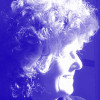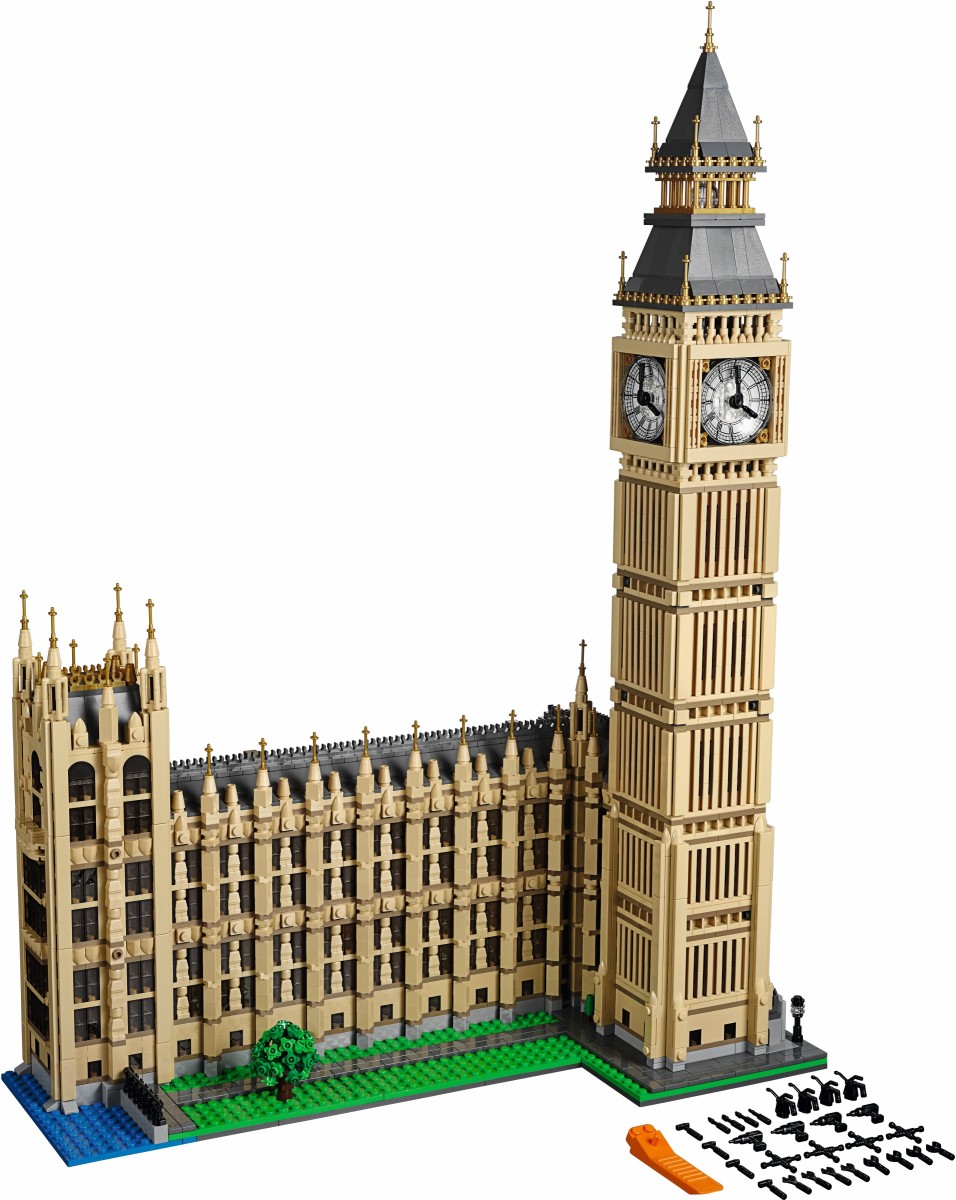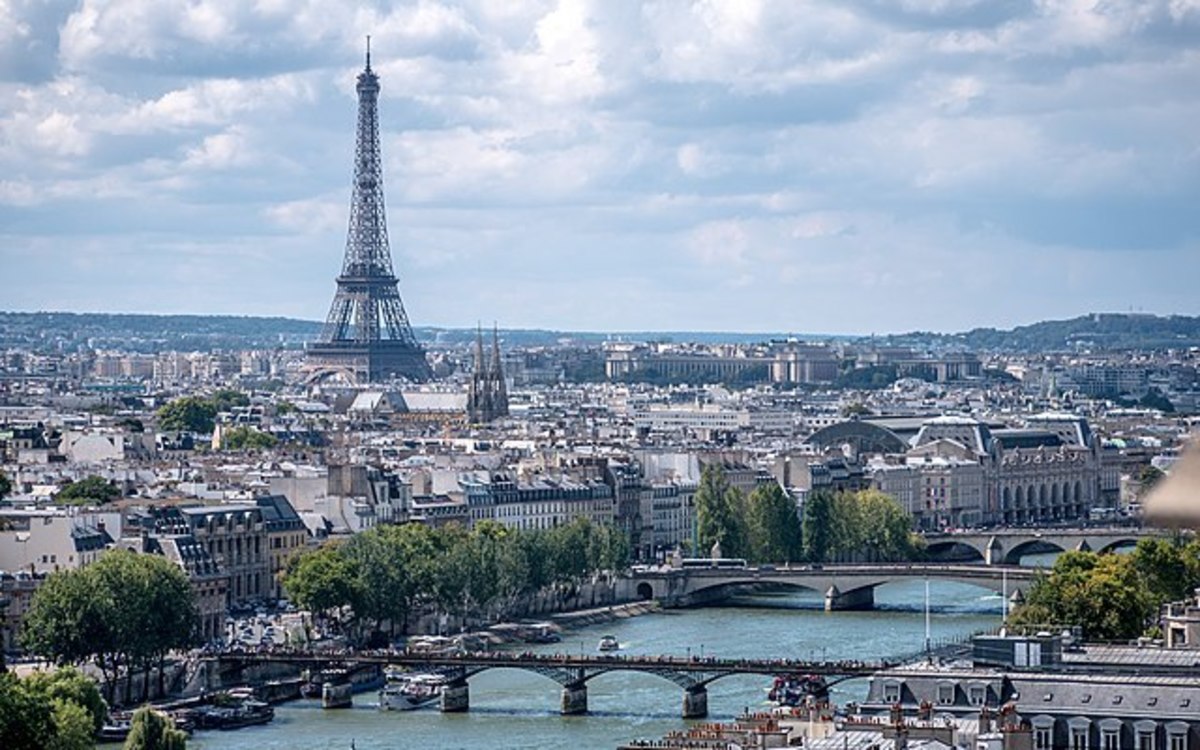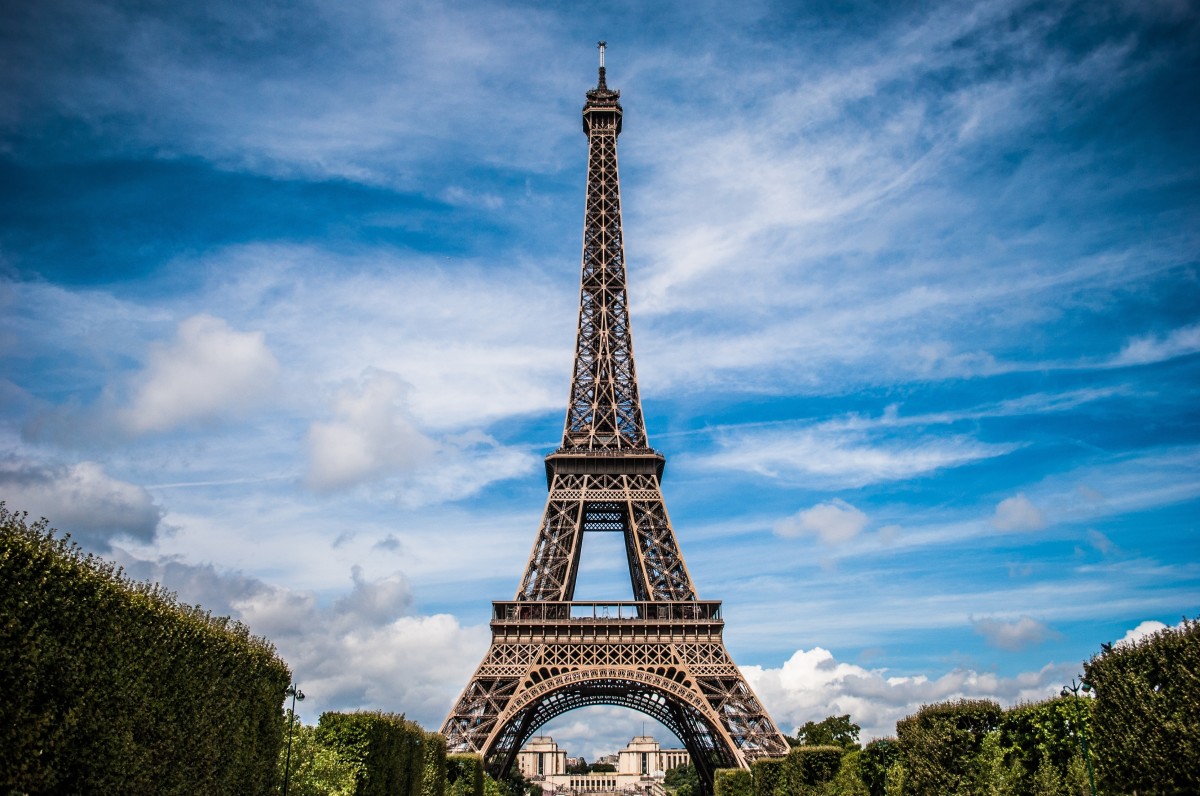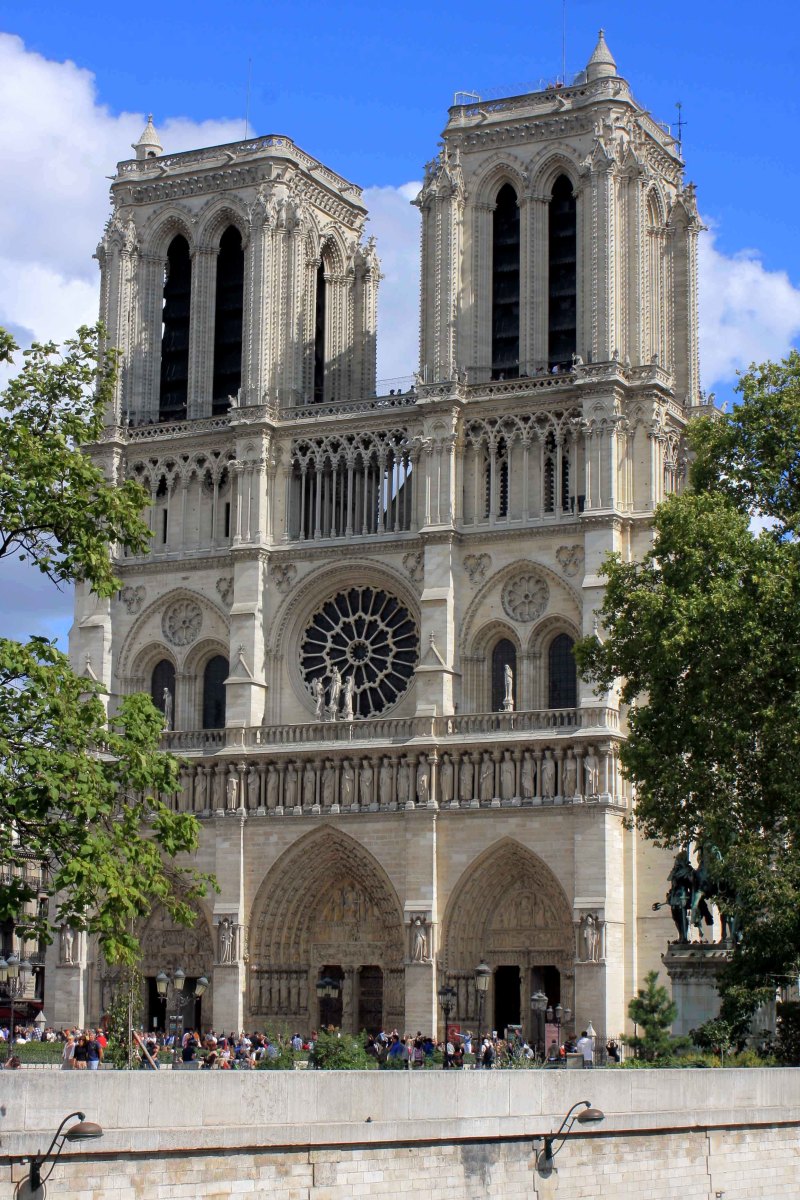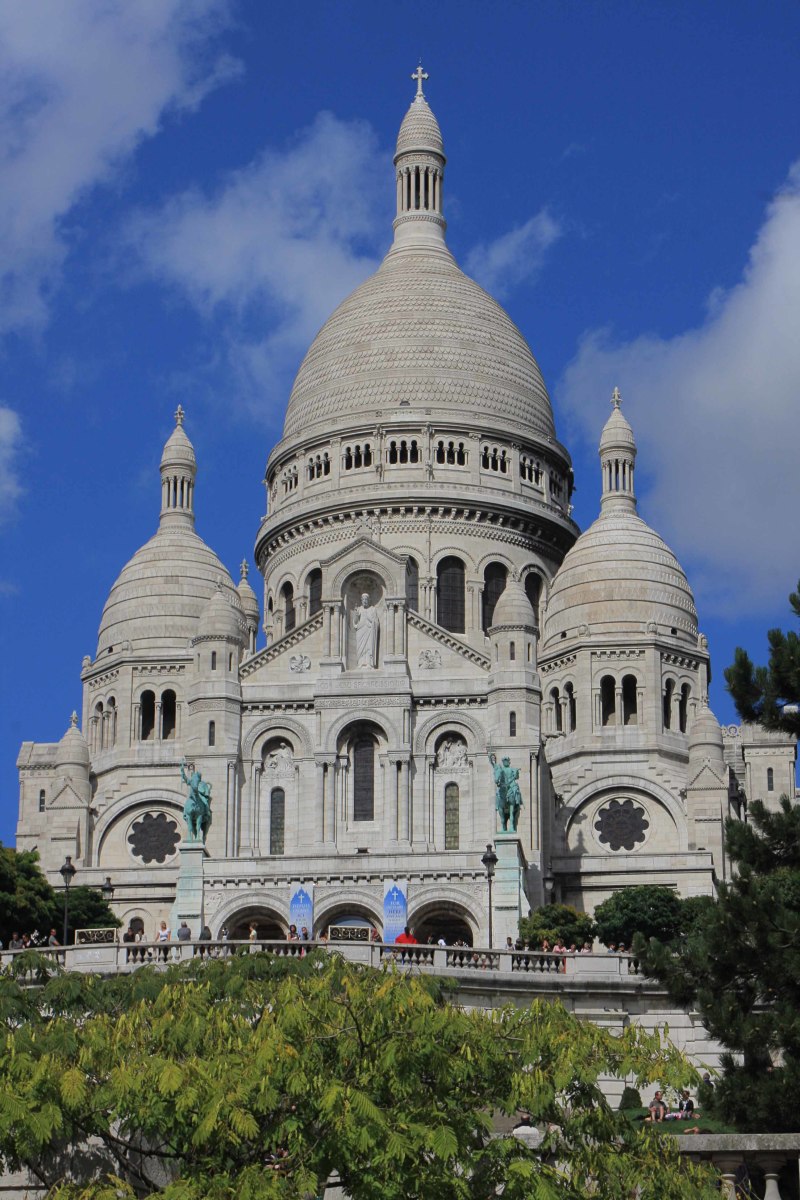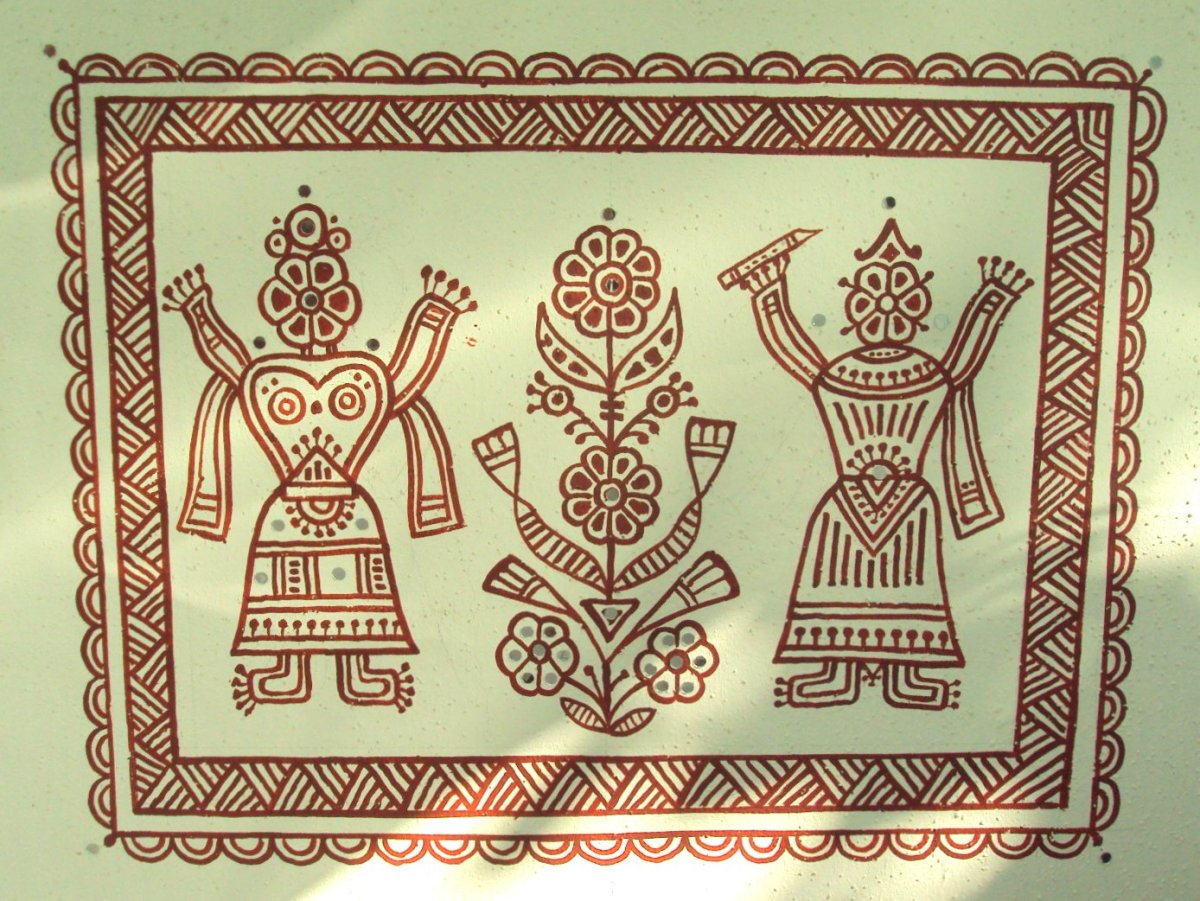Tour Eiffel Tower
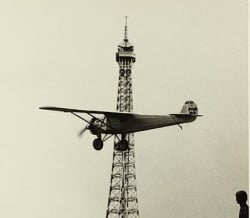
Representations of the Tour Eiffel or the Eiffel Tower
Born from the pure engineering genius of Gustave Eiffel, the Tour Eiffel or Eiffel Tower has become a symbol of Paris and France, and an urban icon that is recognised and loved the world over - as powerful as the red white and blue of the French flag itself. The two are often combined in images, advertising and merchandise.
Right from the start the tower was at once a great tourist attraction, a monument to science and modernity, a political statement and an object that caught the attention of the most creative souls of the day. Artists, writers, poets, philosophers both loved and hated this structure that rose over 300 meters above Paris and was, at the time, the tallest building in the world.
The newest inventions of the 20th century, electricity and film, were put to work, alongside traditional arts and crafts, to capture the image of the Eiffel Tower and it was these depictions, together with representations in many popular forms that were bought by and disseminated by the public who flocked to see the tower which together turned a temporary iron structure into an icon of our times.
The meaning of the tower has also changed. At birth it was a symbol of National pride, of modernity and the prowess of France in new technology and science, but over the years the tower has become associated with romance and love. How has this transformation come about?
Essential Eiffel Tower facts
A few quick facts about the Eiffel tower to ask those frequently asked questions ...
- Who built the Eiffel tower? Gustave Eiffel
- Who designed the Eiffel tower? Gustave Eiffel with help from Emile
Nouguier and Maurice Koechlin.
- Why was the Eiffel tower built? As part of the 'Exposition Universelle' in Paris
- When was the Eiffel tower built? It was finished in 1889
- What is the Eiffel tower height? 324 metres - with antennas!
- Where is the Eiffel tower located? Paris Champs de Mar
- What is the Eiffel tower made of? Puddled iron
- How old is the Eiffel tower? Well it was constructed in 1889 so ....
- How many people visit the Eiffel tower every year? Nearly7 million
- How heavy is the Eiffel tower? 10,100 tonnes
Take a Tour of the Eiffel Tower - Book a guided tour Eiffel Tower
Visit the official Eiffel Tower site to book your tour. The tour of Eiffel Tower, complete with tour guide, will take you behind the scenes at the Eiffel Tower, tell you all about the amazing history of the tower. See how all the machinery works and, of course, enjoy the splendid views - check your tickets, some are second floor only. Group tour Prices (2013): 20,50 euros adult - 18,90 euros /child (-16years).
You can also take in the Eiffel Tower show - breath in the romance! Prices (2013) 15 - 23 euros (with a couple of euros knocked off for children)
Individual tours are available at astronomic prices!
Book a Tour of the Effel Tower
- Booking a tour of the Eiffel Tower
The official Eiffel Tower site
The Story of the Eiffel Tower is Amazing! - The Belle Epoque France meets Buffalo Bill and Annie Oakley,
It is truly astonishing that the Eiffel Tower, the Belle Epoche and Buffalo Bill all come together at the Universal Exhibition in Paris in 1889. It's like a surrealist painting! This stranger-than-fiction account of the birth of the Eiffel tower will totally enthrall you. How can you bear not to know the facts and figures? How can you live another minute without the whole story? (OK, but it is extremely interesting).
More famous people who visited the Exhiition: Eleanor Marx,

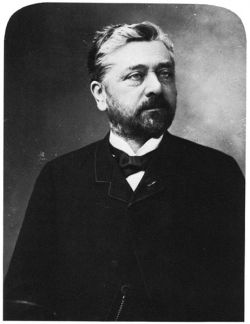
Who Was Gustave Eiffel?
And how did he come to build the Eiffel Tower?
Gustve Eiffel (1832 - 1923) was a talented French engineer and entrepreneur who came to maturity in a time of great change. New technology, the railways, iron structure, photography came at a time when the romantic and picturesque were being superseded by modernity and contemporary life. They were changing every aspect of the world and the way that the world was seen and depicted.
the Eiffel tower was built as part of the Paris Exhibition of 1889 and, situated right in the centre of Paris, marks the final acceptance of iron as an architectural medium.
The roots of modern architecture, with the metal frame playing a central role, goes back to the mid eighteenth century when mills and other large, utilitarian buildings were being constructed from iron to allow greater spans and protect against fire. At the same time the philosophy of art was moving away from the Rococo and Baroque towards a doctrine of 'form following function'.
Throughout the 19th century the city was being transformed by the 'interaction of a number of unprecedented technical and socio-economic forces which first emerged in England in the second half of the eighteenth century including the development of the puddling process for the simplified conversion of cast iron to wrought iron in 1784.
This was a century of industrialisation, of the railways, viaduct, bridges and road-building that would transform the towns and cities as well as the way people lived and worked.
Like all the cities of Europe, Paris was expanding rapidly in the nineteenth century and from 500,000 people in 1801 it grew to 3 million by 1901. This rapid expansion led to slums, degradation and outbreaks of cholera leading to a remodeling of the city by Haussman in 1853.
To celebrate the technical and political prowess of Britain, a Great Exhibition was organised in 1851 housed in a great iron and glass structure designed by Joseph Paxton, and it was in response to this France organised five major international exhibitions between 1855 and 1900. These were intended to be "national platforms from which to challenge the British command over Industry, production and Trade." (A critical History of Modern Architecture by Kenneth Frampton).
Other world fairs followed France's lead - in 1893 Chicago held a fair, which Harry Selfridge helped to organise, where a great Ferris wheel (designed by George Ferris) was erected to 'outdo' the tower.
Gustave Eiffel worked on the Galerie des Machines in the 1867 World Exhibition with the engineer J B Krantz. For the International Exhibition of 1889 it was decided that two buildings were needed, a Galerie des machines designed by Victor Contamin, and a 300m high tower designed by Eiffel with engineers Emile Nouguier and Maurice Koechlin and the architect Stephen Sanvestre.
To achieve a tower of this height and this scale and to erect it in a relatively short timescale, Eiffel resorted to experience gained in the construction of bridges and viaducts. The most notable of these was the Garabit viaduct in the Massive Central built in 1880 - 84 .It was here that he
perfected a system of portable bridges that can be assembled in just a few days by a group of
twelve men.
In 1884 Eiffel presents a project for the construction
of the Tower using the hinged arches and prefabricated elements that would allow the tower to be designed, manufactured and erected in just five years.
The Garabit Viaduct - This engineering miracle paved the way for the Eiffel Tower
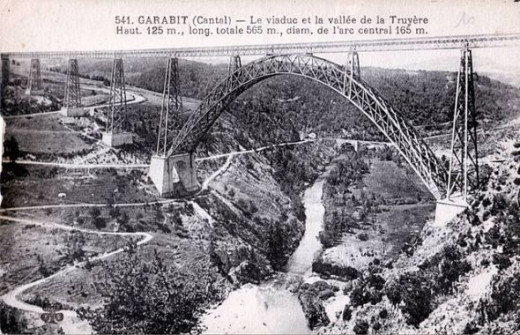
The Garabit Bridge Today
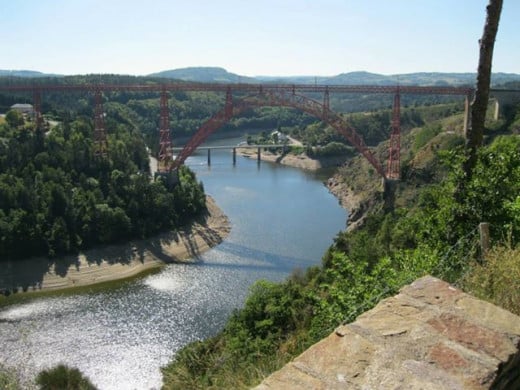

Cartoon Representations of the Eiffel Tower - Many people were critical of the tower
Not everybody fell in love with the Eiffel Tower at first sight. It was called "metal monstrosity," a "giraffe," "cyclops," "skeleton" and "suppository."
French artists, writers and intellectuals who complained in 1887 that it would be "a monstrous symbol of the craven machine age that would destroy both the values and image of the world's most important city".
This Caricature of Gustave Eiffel appeared after a protest by leading artists and writers of the time, including Alexandre Dumas fils, Guy de Maupassant, Charles Gounod, Leconte de Lisle, Victorien Sardou, Charles Garnier, Francois Coppee, Sully Prudhomme, William Bouguereau, Ernest Meissonier. Their protest appeared in Le Temps on the 14 February (Saint Valentine's Day) 1887 and even though the tower was not yet in existence, it was critized for its ugliness.
Eiffel's response was, "La tour sera le plus haut edifice qu'aient jamais eleve les hommes. Ne sera-t-elle donc pas grandiose aussi a sa façon ? Et pourquoi ce qui est admirable en Egypte deviendrait-il hideux et ridicule a Paris ?".
The cartoons show how closely Eiffel was associated with his tower and how closely the links were with international politics, travel and the building of business and commercial links abroad.
Eiffel was a master of business and publicity
Right from it's conception the Eiffel tower was seeped in 'business' and 'publicity'.
Eiffel was not just a talented engineer. He organised the manufacture and building of the tower, but he also used his business skills to ensure that the tower which was originally planned as a temporary construction to be given a much longer life-span. He did this by raising construction money by selling stocks to investors with twenty-year guarantees to the profits of the restaurants, theatre and souvenir stands.
Eiffel ran a publicity campaign during the building of the Tower that included many photographs of the building as it was being built. These, together with the construction drawings, are the earliest representations of the tower, and it was the souvenirs sold on the stands that would help to transform the monument into an icon.

What Did the Eiffel Tower Represent in 1889?
The meaning of the Tour Eiffel
The Eiffel Tower was a sensational building at the time of its construction both because of its height, it would be the tallest structure in the world, and because of the modernity and utilitarian connortations of its iron construction and its association with rationality and scientific progress. As the editor of a popular scientific magazine put it, it would be the 'arc de Triumph of science and industry'. It would metamorphose Republican ideology into monumental display.
It was also significant that the Tower was also part of the celebrations for the Centennial of the French Revolution.
It is clear that the exhibition was a response to Expositions held in Europe and America from the mid-century onwards; a chance to show the world that France was also one of the foremost countries in engineering and technology, however it was none of these things that transformed the Eiffel Tower from a temporary monument into an urban icon.
This iconic status was achieved by virtue of its size, its shape and its 'raison d'etre' as a tourist attraction.
The streamline shape of the tower that reached skyward had, until this point, been reserved for church spires and buildings devoted to God and this was a time before the skyscraper made such building ubiquitous although the tower foreshadowed these events.
The form of the tower, with its wide base narrowing to a point and constructed with open ironwork to minimize the pressure of the wind was so unlike any other building before or since that it was, and has remained unique (despite replicas in such as in Tokyo.
Eiffel's Tower was intended to be an Icon of Science and a symbol of the new world of technological discovery. Right from the start Eiffel proposed that it would be used for scientific experimentation: telegraphic communication, meteorology and astronomy as well as being a beacon of light however, despite this, in the end the Tower had little purpose other than to be seen and visited, in short, it is a work of art.
As a tourist attraction it was an amazing success. There were almost 2 million visitors between May and November in 1889. Not only did the Tower have both elevators and stairs but there were also toilets and mailboxes as well as the commercial money-spinners; the restaurants, souvenir stands, a theatre, and its own 'newspaper' Le Figaro de la Tour.
The Tower dominated the city from afar, but also provided a vantage point from which the city could be seen.
The Eiffel Tower was a star attraction right from the word go. Amongst the eminent people who visited it were Buffalo Bill and Annie Oakley, Thomas Edison, the artists Whistler, Gauguin, and van Gogh.
The Eiffel Tower Dominates Paris - It is also a viewing point for the city
The Tower was both dominated Paris visually, but it also acted as a point from which a birds eye view of Paris could be seen. out and object to be seen.
Representations of the Tour Eiffel on Postcards and Stamps - Tourism, commerce and travel create an international symbol for the city of Paris
Paris in the late nineteenth century was the most visited city in the world and the Eiffel Tower would both exploit and augment tourism. These postcards of the Eiffel Tower exploit the shorhand image used from this time onwards to denote Paris and are ideal objects to disseminate the symbol across the globe. Along with a plethora of other popular images and icons, the image of the Eiffel Tower was affordable and sold to the masses to be posted or given to people who would perhaps never see the tower in the flesh creating one of the first 'modern urban icons'.
It has even been thought that the first picture postcards were produced by the newspaper, Le Figaro, sold and mailed on the spot during the Exposition in 1889.
This 'post-card' Paris was the first manifestation of a commercial visual culture which was emerging in the late nineteenth century and which led, finally, to the movies.
Art and the Eiffel Tower
During the inter-war years, avant-garde artists and poets such as Guillaume Apollinairecontinued to use the Eiffel Tower as a subject. Just some of the artists who created new and powerful images of the tower include Robert Delaunay, Marc Chagall, Romaine Brooks, Raoul Dufy, Gino Severini, Pol Bury, Utrillo, Bernard Buffet, Roger Lersy and Nicolas de Staël.
Georges Garen - Embrasement de la Tour Eiffel
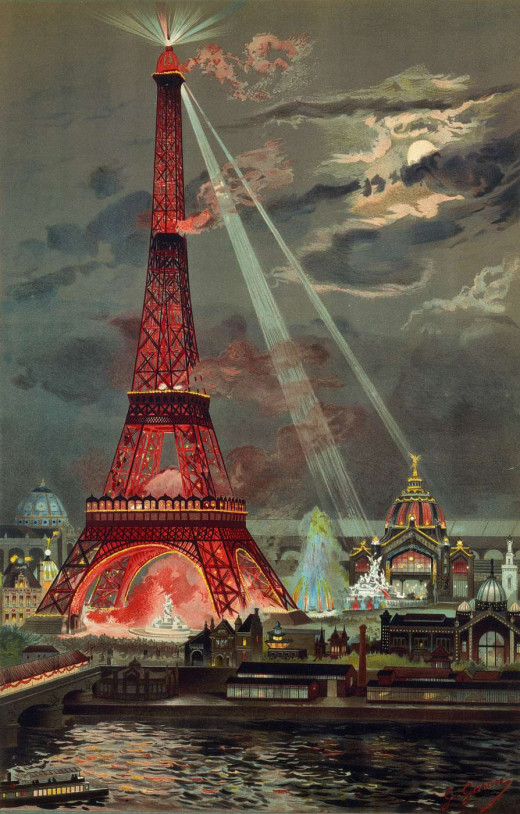
How Did The First Artists Represent the Eiffel Tower? - Representations of the Eiffel Tower on paper and canvas
Ahead of their time, many painters chose to paint the Eiffel Tower and it remains a favourite subject for artists.
One of the very first artists to paint the tower was Georges Seurat (1859-1891). He painted it in 1888, before it was even finished. It was fitting that an artist dedicated to modernity, the newly emerging cityscapes with their factories and industrial suburbs, to new methods of printing and the new technology for creating images via light, photography, should immediately embrace the stunning modernity and daring of the Eiffel Tower using the pointillist method derived from the new printing processes to conj our up the not-yet-finished shape of the tower.
Other artists to paint the tower in the nineteenth century were Vuillard, Dufy, Signac, Bonnard, Utrillo, Gromaire, 1889 - Jean Beraud : 'Entree de l'Exposition Universelle ' , 1890 - Le Douanier Rousseau : 'Moi-meme, portrait paysage ', 1890 - Paul Signac : "Seine Grenelle'
One of the Earliest Paintings of the Eiffel Tower

Science and the Eiffel Tower
Representations of the Eiffel Tower as a symbol of the power of science and technology
Representations of the Eiffel Tower as A Radio and TV Mast - La Tour Eiffel becomes a radio and TV transmittor
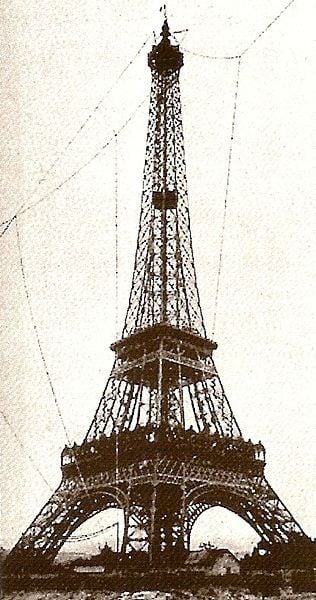
Gustave Eiffel was a scientist as well as a visionary engineer. He set this devotion to science in stone - or rather in metal, when he wrote the names of 72 scientists of the 18th and 19th centuries on the facades of the Eiffel Tower.
It was his interest in science and the latest technology that led to the Eiffel Tower being known as 'The Big Ear'
On November 5, 1898, the first wireless connection was made by Eugene Ducretet and his associates between the top of the Eiffel Tower and the Pantheon - a distance of 4 km.
During the war in 1903 Gustave Eiffel offered the site of the Tower to set up antennas for radio transmission experiments and from 1904 the Tower was used for a military wireless transmission network and progress was made so rapidly that in October 25, 1915, The Eiffel Tower received a message from Arlington, Virginia (USA). 'The voice of America' could now cross the Atlantic ocean.
During World War I, the Tower became known as the 'Big Ear' due to the
part it played in intercepting the enemy's messages, and in 1914 it was via the tower that the news arrived that German soldiers were arriving East of Paris. The tower was also responsible, indirectly via the radio, for the arrest of the spy Mata Hari in 1915.
In November 1921, the Eiffel Tower broadcast its first radio
programme and went from strength to strength until it stopped broadcasting when the Germans
reached Paris in 1940.
After World War II, the installations were repaired the Eiffel Tower was able to broadcast the coronation of Queen Elizabeth II of England in 1953. Today the Eiffel Tower makes TNT broadcasting possible.
The Eiffel Tower as Meteorological Observatory - Eiffel's weather, astronomy and aerodynamics laboratories
This original 1890 article is about the Meteorological Observatory situated at the top of the Eiffel Tower. The station had thermometers, a hygrometer, anemometers, and recording mercurial barometer.
Eiffel also had an office devoted to measurements relating to astronomy, physiology and aerodynamics where he carried out research work about the fall of bodies.Some time later he was to design a monoplane fighter and carry out research on the span of the wings and on the propellers.
The Eiffel Tower itself was of great interest to other aeronautics.
The Eiffel Tower and Aviation - Representations of the Eiffel Tower and Innovations in Flight
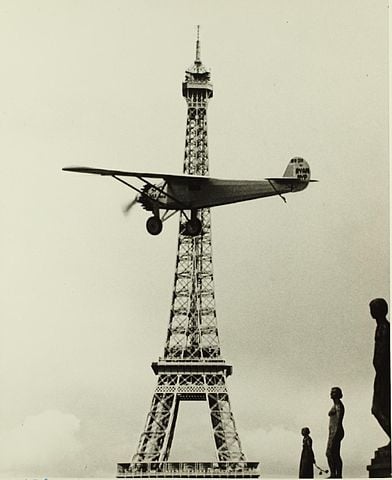
Pilots were attracted to the Tower like bees to honey. In 1901 Santos-Dumont won a prize for flying higher than the Tower in an airship. Many others flew around and over the tower in planes and balloons, but some were not so lucky. In 1912, Mr. Reichelt, called 'the bird man', killed himself when he jumped from the first floor of the tower using a parachute made by himself, and in 1926 Leon Collot, killed himself trying to fly under the Eiffel Tower.
What Does The Eiffel Tower Represent Now?
Contemporary Meanings of the Tour Eiffel
The Eiffel Tower as an Urban Icon
A symbol of Paris and so of France
Roland Barthes said, "The Tower is also present to the entire world. First of all as a universal symbol of Paris' it is everywhere on the globe where Paris is to be stated as an image."
The Eiffel Tower has come to stands for Paris but also, in-as-much as Paris stands for France, it has become the symbol of the country.It has become an 'urban icon' it sits at the point that visual culture intersects with urban history.
Part of the reason for the tower's elevation to the status of icon lies in the fact that it is both of it's time in the 'Belle Epoque' of Paris at the turn of the century, and it is also a monument to modernity. The 'Grande Dame en Fer' never ages, and is always old.
Mass-Production and Iconization - So many Eiffel Towers as souvenires
The Tower's simple structure was simple to reproduce for souvenirs: in sweets, in key chains, as charms furniture and a never-ending range of Eiffel towers. In other words, 'kitsch'. It was these mass-produced souvenirs that made the tower so popular and easily recognisable.
War and Peace - Idols and Icons
The iconic nature of the tower has led others to borrow it's fame and power in order to create icons of themselves. the famous and infamous as varied as Adolf Hitler, Edith Piaf and Andy Warhol have all posed before the tower in their quest for immortality and association with Paris, France and all that this stands for.
The Tower Becomes A Symbol of Romance
I love the Eiffel Tower, Paris and France!
Not only do people love Paris, the symbol of Paris and France, but people began to associate romantic love with the city and with the tower. The Eiffel Tower becomes an icon of love and romance.
Photography - the Marriage of Art, Light and Technology - The Eiffel Tower represents love, beauty and romance
Paris, the Eiffel Tower, love and romance have all been intertwined through the popular images created by photographers in the twentieth century. Seurat was inspired by photography, as were Monet, Degas and many of the other artists at their peak when the Eiffel Tower was built. They fell in love with the science, but since then, photography has been used to capture the love felt for the Eiffel Tower.
Perhaps Robert Doisneau is the most famous artist of all to capture the romance of the tower on film.
I love the Eiffel Tower
Some People Have Loved the Tower So Much They've Married It - Meet Mrs Erika Eiffel
Yes, Paris is a city for lovers, and the Eiffel Towers has become a symbol of that romance, but some take the love much further. Erika Eiffel (born Erika LaBrie) married the Eiffel Tower in 2007 in a civil ceremony; this is Erika's love Story ...;
"Erika loves things. Many things, but not as we love our possessions or lust after objects of desire - Erika loves those objects, desires those objects as lovers, as life-time companions. Erika is a warrior, she shoots arrows, like Katniss Everdeen, with a longbow. Erika love archery and she loves her bow, Lance. She really loves Lance!
But her love flowed over. She needed more power, more to pour her love over and into. She needed an object of desire that would be overpowering, massive, strong and steady. A lover that would always be there for her. A lover as powerful as her own. She met that lover in 2004 and the romance began. "Oh! Eiffel Tower, Eiffel Tower - how I do love thee!"
She had other strong, unyielding and powerful lovers too, the Berlin Wall was one. This affair was celebrated in music and drama in the theater production "Erika's Wall." Erika's lovers have made her star. She can now live happily ever after in the sure knowledge that her partner will be faithful and steadfast. The object of her love will never leave her."
THE END?
Erika Eiffel is founder of OS Internationale, an organization for other lovers of inanimate objects, known as objectophiles.
Representations of The Eiffel Tower in Film
The Eiffel Tower has starred in many movies
It is only a short step between the Tower in photographs to the Eiffel Tower in movies
The Tower was born along with the development of cinema and electrical lighting. The tower was born of light.
Such new technologies as film and electrical lighting were both, like the tower itself, part of urban life. The film came just six years after the tower was built and, by 1900 it was also part of a Universal Exposition.
It goes without saying that the film would be eager to capture it's sister icon, the Eiffel Tower. It is a star in Rene Clair's Paris Qui Dort, or the 1949 Man on the Eiffel Tower.
One of the first films by the Lumière brothers, said to be the inventors of cinema, was made in 1895. In 1897 and was called 'Panorama pendant l'ascension de la Tour Eiffel'
(Panoramic view while climbing the Eiffel Tower).
In 1900, Georges Méliès filmed the Tower and in 1906, George Hatot produced 'La course à la perruque' (Running
after the wig).
Others to use the Eiffel Tower in film include Louis Feuillade, with the series called Fantômas, René Clair, Abel Gance, Baz Luhrmann, Ron Howard and in 2006, film director Simon Brook's documentary is about the construction of the Tower 'La légende vraie de la Tour Eiffel (The true legend of the Eiffel Tower).
Most recently the tower appears in 2007, Brett Ratner's movie Rush Hour.
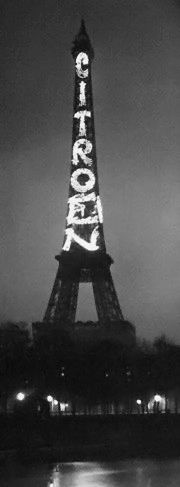
Light, Advertising and the Tour Eiffel
The tower is a powerful image
Like film, electrical lighting was to come into it's own just shortly after the construction of the tower, and like the tower, it was an invention of the city. The Tower was not lit itself until 1900 with the widespread use of electricity, although spotlights had illuminated it in 1889.
Electric lighting both illuminated and dematerialized the city until they became scintillating spots of light. the night came alive.
From as early as 1888, the tower became a support for firework displays and light was considered to be an art form in itself, to the point that the light displays have been placed under copyright.
In 1937 André Granet designed a lighting display whereby every evening, fireworks were set off from each of the Tower's three floors to cascade down the building.
Other memorable light events took place when celebrating the Year 2000, and on the 14th July 2009, the firework display was held not at the Trocadero, but at the Eiffel Tower.
Between 1925 and 1937 the car manufacturer, Andr' Citro'n,illuminated the tower with the name of his factory and so the tower stepped seamlessly into the realm of publicity and advertising. The Tower is the symbol of Paris and France and so it follows that it would often be used in advertisements related to Parisian or national companies. It has been used to advertise Paris airports, Air France, La Samaritaine, Philips, Alain Afflelou, ADP, American Express, Sony Ericsson, designers and parfumiers such as Yves-Saint-Laurent, Jean-Paul Gaultier, Nina Ricci, Dior, and Givenchy.
Tour Eiffel Illuminated - Light and the Eiffel tower
I remember the first time my son, then aged about 7, saw the Eiffel tower illuminated with thousands of twinkling lights. It was midnight, it was warm, it was Paris, he had been allowed to stay up for the occasion and he was transfixed.
It was truly like something out of Disney, but instead of a sham of reality, this was make-believe come true.

Amazing Eiffel Tower Fireworks Set To Music by UTOOBASAURUS
Business Continues to Sell the Image of the Eiffel Tower

The Eiffel Tower Worshipped in Word, Music and Song - Hommage has been paid to La Dame de Fer in so many ways
We worship at the very feet of the monument, offering praise not only in the graven image and in light, but in words of literature, poetry and discourse, in music and in song, in dance and theatre. The tower, a secular spire, mimics the Church in so many ways.
One of the may grand and elaborate events which has taken place at the foot of the tower was held on 25th September 1962 by Darryl F. Zanuk to launch of the film "Le jour le plus long" ("The Longest Day"). it was then that Edith Piaf appeared on the 1st floor of the tower and sang in front of 25,000 Parisians.
Other singers would follow; Charles Aznavour and Georges Brassens helped to campaign against hunger in 1966. Jean-Michel Jarre, The "3 Tenors" - José Carreras, Placido Domingo and Luciano Pavarotti and even Johnny Hallyday all entertained massive crowds in hoour of La Dame de Fer.
Private concerts or receptions can be held in the room on the 1st floor and many stars have taken advantage of this including Alanis Morissette, Veronique Sanson, Robbie Williams, Christophe Mae, Justin Bieber, Texas, Raphael, Marc Lavoine, and VV Brown .
Some of the songs that give praise to the tower include : Paris, mais c'est la Tour Eiffel by Michel Emer, Y a d'la joie, la Tour Eiffel part en balade by Charles Trenet, La Tour Eiffel a froid aux pieds by Leo Ferre, Jacques Dutronc, Je suis tombe pour elle by Pascal Obispo
Listent to Sizzling Rekha Singing Eiffel Tower - Bachke Rehna Re Baba:
Eifel Tower I Got Power Bachke Rehna Re Baba
More E T Questions That People Often Ask - There is so much to know about the tower
- Eiffel Tower how many steps? 1665
Where Did I Get My Information - Links to sources
- Wikipedia
Always a good place to start - History
Some interesting facts - The Eiffel Tower Vanessa Schwartz
An excellent essay on representation and the Eiffel Tower
Are you in love with the Eiffel Tower?
© 2013 Barbara Walton
